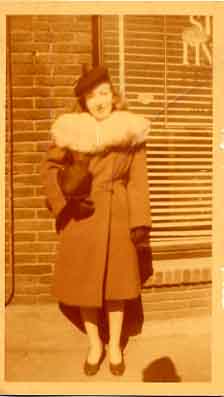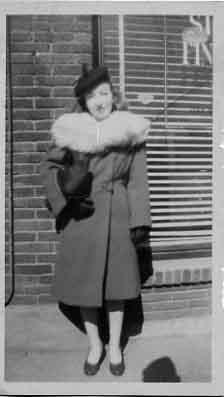 Re-trato de Familia made me reflect on my own family, the role art plays in my life as a passion and avocation, and how removed I feel from the migration my family made to the United States in 1898. What aesthetic parts of me had I inherited from my family? What traditions may be born from this? Art as part of my own childhood began generations ago with my great-grandmother's sewing in the Lower East Side at the beginning of the century. This labor in harsh conditions was a necessity for Fanny, not a means of creative expression. My grandmother, on the other hand, has a penchant for fashion and even today is often the best-dressed member at family functions. More gifts of love than expressions of soul, she turned to elaborate needlepoint as her other creative outlet. Years would go by with her working on one large piece such as quilts or crocheted blankets. My mother focused her creative energies into food preparation, then later, writing about that passion. She has become an authority on New Jersey's restaurants and now writes a column. I couldn't help but wonder: What would an exhibit of the artistic work of the four recent generations of my family, or the generations to come, look like? With all these creative impulses and eclectic interests, our show would probably be more like a bazaar than a swank gallery opening.
Re-trato de Familia made me reflect on my own family, the role art plays in my life as a passion and avocation, and how removed I feel from the migration my family made to the United States in 1898. What aesthetic parts of me had I inherited from my family? What traditions may be born from this? Art as part of my own childhood began generations ago with my great-grandmother's sewing in the Lower East Side at the beginning of the century. This labor in harsh conditions was a necessity for Fanny, not a means of creative expression. My grandmother, on the other hand, has a penchant for fashion and even today is often the best-dressed member at family functions. More gifts of love than expressions of soul, she turned to elaborate needlepoint as her other creative outlet. Years would go by with her working on one large piece such as quilts or crocheted blankets. My mother focused her creative energies into food preparation, then later, writing about that passion. She has become an authority on New Jersey's restaurants and now writes a column. I couldn't help but wonder: What would an exhibit of the artistic work of the four recent generations of my family, or the generations to come, look like? With all these creative impulses and eclectic interests, our show would probably be more like a bazaar than a swank gallery opening.
 And yet, despite their differences, and spatial segregation in different enclaves around a courtyard, the works seem to be both in dialogue with and vacuum from one another. Mario's brilliant color forms speaking with Jaimie's straight color photographs. They didn't seem to gang up on Igal, though, the lack of color and the hearkening to a different time, set him apart as nostalgic. Yet it is he who most definitively aligns himself with the past and with the aesthetics of another age. Am I imposing dialogue because it's a family show of works displayed in the same building? Or maybe it's the literalist in me seeking reconciliation between the different artistic media with shared DNA? Is it na´ve and simple to point out the singular shared form: the expression of the window?
And yet, despite their differences, and spatial segregation in different enclaves around a courtyard, the works seem to be both in dialogue with and vacuum from one another. Mario's brilliant color forms speaking with Jaimie's straight color photographs. They didn't seem to gang up on Igal, though, the lack of color and the hearkening to a different time, set him apart as nostalgic. Yet it is he who most definitively aligns himself with the past and with the aesthetics of another age. Am I imposing dialogue because it's a family show of works displayed in the same building? Or maybe it's the literalist in me seeking reconciliation between the different artistic media with shared DNA? Is it na´ve and simple to point out the singular shared form: the expression of the window?
Would my family's work be in dialogue, or would each person stand alone? Would the exhibit capture the love or angst that moves within our family, or would it betray some of the estrangement we've acquired in the new world? Would they fall flat in the at-times desolation of living in America with the large distance from any traumatic migration, like the displacement of Jews, of Arabs and perhaps, any of Guatemala's varied indigenous populations. Is it the medium or message that brings these works together, or further apart? At their best, family exhibits like Retrato de Familia transcend these and other questions, as individual expression blends with continuity of influence, both expressing the human spirit in the face of adversity.

A reappraisal of the Modigliani la juif
August, 2004
Eternal Sunshine: The Ultimate Passover Movie
April, 2004
Robert Meeropol's An Execution in the Family
January, 2004
Historical revisionism and the new antisemitism in academia.
January, 2004
Lost in Translation: A snapshot of the evansescent
October, 2003
Constitutive ritual for distributed families
May, 2003
James Turrell and the truth of light
April, 2003
The ambiguities of art and life
March, 2003
The soft borders between Jewish particularism and universalism
February, 2003
What my grandmother's suffering teaches
January, 2003
What is modernism?
July, 2002
What's the difference between laughing with art and laughing at it?
June, 2002
What draws protesters to banal holocaust art?
April, 2002



Singing God's Praises:
Psalms and Authenticity
Josh Feigelson
Two Prayers for the Days of Awe
Rabbi Zalman Schachter-Shalomi
How can you be gay and Jewish?
Jay Michaelson
Hiding your Sins
Hal Sirowitz
Retrato de Familia
Bara Sapir
Jews and Bush
An Online Resource Guide
Archive
Our 550 Back Pages
Saddies
David Stromberg
Zeek in Print
Spring/Summer 2004 issue now on sale!
About Zeek
Mailing List
Contact Us
Subscribe
Tech Support
Links
From previous issues:
Wisconsin
Chanel Dubofsky
The Spiritual Foundations of Bushism
Jay Michaelson
 Email us your comments
Email us your comments